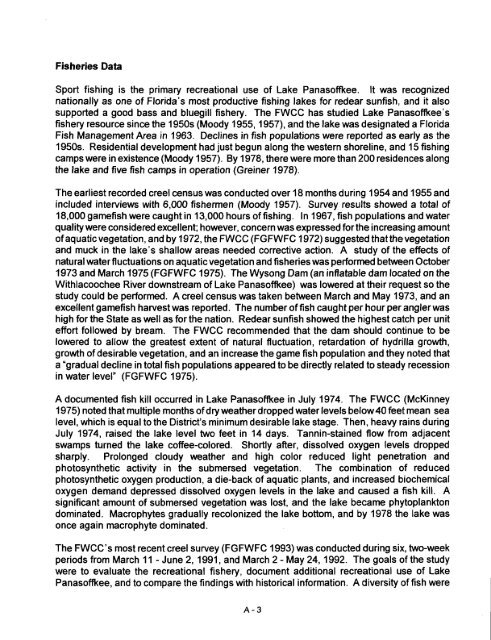Lake Panasoffkee SWIM Plan - Southwest Florida Water ...
Lake Panasoffkee SWIM Plan - Southwest Florida Water ...
Lake Panasoffkee SWIM Plan - Southwest Florida Water ...
You also want an ePaper? Increase the reach of your titles
YUMPU automatically turns print PDFs into web optimized ePapers that Google loves.
Fisheries Data<br />
Sport fishing is the primary recreational use of <strong>Lake</strong> <strong>Panasoffkee</strong>. It was recognized<br />
nationally as one of <strong>Florida</strong>’s most productive fishing lakes for redear sunfish, and it also<br />
supported a good bass and bluegill fishery. The FWCC has studied <strong>Lake</strong> <strong>Panasoffkee</strong>’s<br />
fishery resource since the 1950s (Moody 1955,1957), and the lake was designated a <strong>Florida</strong><br />
Fish Management Area in 1963. Declines in fish populations were reported as early as the<br />
1950s. Residential development had just begun along the western shoreline, and 15 fishing<br />
camps were in existence (Moody 1957). By 1978, there were more than 200 residences along<br />
the lake and five fish camps in operation (Greiner 1978).<br />
The earliest recorded creel census was conducted over 18 months during 1954 and 1955 and<br />
included interviews with 6,000 fishermen (Moody 1957). Survey results showed a total of<br />
18,000 gamefish were caught in 13,000 hours of fishing. In 1967, fish populations and water<br />
quality were considered excellent; however, concern was expressed for the increasing amount<br />
of aquaticvegetation, and by 1972, the FWCC (FGFWFC 1972) suggested that thevegetation<br />
and muck in the lake’s shallow areas needed corrective action. A study of the effects of<br />
natural water fluctuations on aquatic vegetation and fisheries was performed between October<br />
1973 and March 1975 (FGFWFC 1975). The Wysong Dam (an inflatable dam located on the<br />
Withlacoochee River downstream of <strong>Lake</strong> <strong>Panasoffkee</strong>) was lowered at their request so the<br />
study could be performed. A creel census was taken between March and May 1973, and an<br />
excellent gamefish harvest was reported. The number of fish caught per hour per angler was<br />
high for the State as well as for the nation. Redear sunfish showed the highest catch per unit<br />
effort followed by bream. The FWCC recommended that the dam should continue to be<br />
lowered to allow the greatest extent of natural fluctuation, retardation of hydrilla growth,<br />
growth of desirable vegetation, and an increase the game fish population and they noted that<br />
a ‘gradual decline in total fish populations appeared to be directly related to steady recession<br />
in water level” (FGFWFC 1975).<br />
A documented fish kill occurred in <strong>Lake</strong> <strong>Panasoffkee</strong> in July 1974. The FWCC (McKinney<br />
1975) noted that multiple months of dry weather dropped water levels below40 feet mean sea<br />
level, which is equal to the District‘s minimum desirable lake stage. Then, heavy rains during<br />
July 1974, raised the lake level two feet in 14 days. Tannin-stained flow from adjacent<br />
swamps turned the lake coffee-colored. Shortly after, dissolved oxygen levels dropped<br />
sharply. Prolonged cloudy weather and high color reduced light penetration and<br />
photosynthetic activity in the submersed vegetation. The combination of reduced<br />
photosynthetic oxygen production, a die-back of aquatic plants, and increased biochemical<br />
oxygen demand depressed dissolved oxygen levels in the lake and caused a fish kill. A<br />
significant amount of submersed vegetation was lost, and the lake became phytoplankton<br />
dominated. Macrophytes gradually recolonized the lake bottom, and by 1978 the lake was<br />
once again macrophyte dominated.<br />
The FWCC’s most recent creel survey (FGFWFC 1993) was conducted during six, two-week<br />
periods from March 11 - June 2,1991 , and March 2 - May 24,1992. The goals of the study<br />
were to evaluate the recreational fishery, document additional recreational use of <strong>Lake</strong><br />
<strong>Panasoffkee</strong>, and to compare the findings with historical information. A diversity of fish were<br />
A-3
















